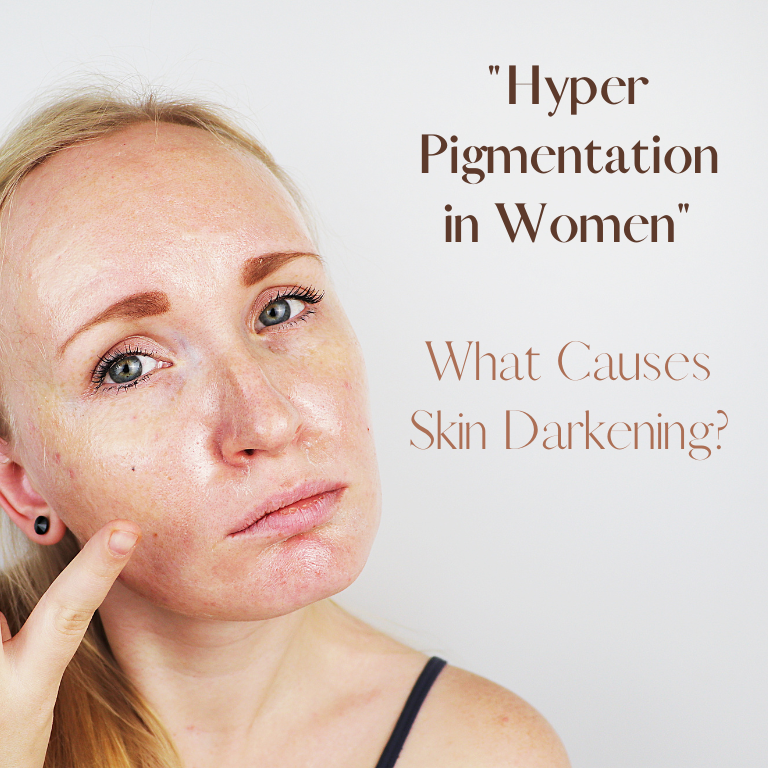
The Mystery of Hyperpigmentation in women: What Causes Skin Darkening?
Hyperpigmentation is a condition in which patches of skin become darker in color than the surrounding skin. It is caused by an increase in melanin production, which is the pigment responsible for skin color.
Hyperpigmentation is a common skin condition & it affects people of all genders, races & ethnicities.

The prevalence of Hyperpigmentation varies depending on many factors, including skin type, sun exposure, hormonal changes, and the use of certain medications.
According to some estimates, Hyperpigmentation affects up to 90% of women at some point in their lives. Women with darker skin tones, who are more susceptible to Hyperpigmentation, may be particularly affected.
Additionally, conditions such as melasma, which is a form of Hyperpigmentation, are estimated to affect up to 6 million women in the United States alone.
However, certain ethnicities, such as those with darker skin tones, are more susceptible to pigmentation changes due to the increased amount of melanin in their skin.
For example, individuals with African, Asian, Hispanic, and Mediterranean ancestry are more likely to develop Hyperpigmentation due to the increased melanin in their skin.
Why are darker skin tone females more prone to pigment issues?
Darker skin tones naturally have more melanin, the pigment responsible for providing color to the skin, than lighter skin tones. This increased amount of melanin provides a higher level of protection from the harmful effects of UV radiation from the sun.
However, this increased amount of melanin also makes individuals with darker skin tones more susceptible to pigmentation issues, such as Hyperpigmentation. This is because the increased melanin production in response to sun exposure can lead to an accumulation of pigment in certain areas, resulting in dark spots or patches on the skin.
Additionally, certain skin conditions, such as melasma, are more common in individuals with darker skin tones and can result in pigmentation changes. Hormonal changes, such as those that occur during pregnancy, can also trigger an increase in pigmentation in individuals with darker skin tones.
What causes Hyperpigmentation to develop in females?
1: Sun exposure

Sun exposure can cause an increase in pigmentation, or Hyperpigmentation, because it triggers the production of melanin, the pigment responsible for providing color to your skin. When the skin is exposed to UV rays from the sun, the melanocytes, the cells that produce melanin, respond by producing more melanin.
This increased melanin helps protect the skin from further damage by absorbing the UV rays.
However, when the skin produces too much melanin, it can accumulate pigment in certain areas, resulting in dark spots or patches on the skin. This type of Hyperpigmentation is known as solar lentigines, age spots, or sun spots.
Hyperpigmentation can be especially problematic for individuals with darker skin tones, as they are more susceptible to pigmentation changes due to the increased amount of melanin in their skin.
Protecting your skin from the sun is recommended by wearing protective clothing and using broad-spectrum sunscreen with a high SPF.
2: Hormonal changes

Women undergo various hormonal changes throughout their lives, such as during puberty, menstrual cycles, pregnancy, menopause, etc. These fluctuations can significantly impact their skin.
It can impact the production of melanin, the pigment responsible for providing color to the skin, and lead to pigmentation issues.
During pregnancy, hormonal changes, such as an increase in estrogen levels, can stimulate the production of melanin and result in the appearance of dark patches on the skin, known as melasma or the “mask of pregnancy.”
During menopause, hormonal changes can impact the production of melanin, the pigment responsible for providing color to the skin, and lead to pigmentation issues called “Melasma.”
A decrease in the production of hormones, including estrogen and progesterone, characterizes menopause. This hormone decrease can impact the skin’s ability to produce and distribute melanin, leading to an increased risk of pigmentation changes.
Additionally, as women age, the production of estrogen and progesterone decreases, which can cause the skin to thin and lose its elasticity, making it more susceptible to sun damage, which can cause pigmentation issues.
It’s important to note that not all women experience skin pigmentation issues during menopause, and the severity of these issues can vary from person to person.
3: Post-inflammatory Hyperpigmentation (PIH) is a skin condition that results in the darkening of the skin due to an injury or trauma.

This can occur after a cut, burn, acne, eczema, psoriasis, or other skin inflammation. In response to the injury, the skin produces more melanin, the pigment that gives color to the skin, causing it to darken.
4: Genetics

Melasma is more common in people with a family history of the condition, which suggests that genetics may play a role.
The exact cause of melasma is not well understood, but having a family history of the condition can increase your risk of developing it.
Research has shown that there may be a genetic component to melasma and that specific genes may play a role in the development of the condition. If someone in your family has had melasma, you may be more likely to develop it yourself.
It’s essential to remember that having a family history of melasma does not guarantee that you will develop the condition. Other factors, such as sun exposure, hormonal changes, and skin irritation, can also play a role in the development of melasma.
5: Skin irritation from certain skin care products can trigger melasma’s development.

Certain ingredients in skin care products, such as alpha-hydroxy acids (AHAs) and beta-hydroxy acids (BHAs), can cause skin irritation and make the skin more susceptible to sun damage. This, in turn, can trigger the development of melasma.
In addition, some skin care products can cause an inflammatory response in the skin, which can also trigger the production of melanin and lead to the development of melasma.
It’s essential to be mindful of your skincare products and avoid products known to cause skin irritation. You should choose safe and gentle products for your Skin, and they are less likely to trigger the development of melasma.
If you want an ethically made, premium quality, natural, herbal Naturo Essentials body & hair wash, here’s the one I formulated for my patients – now it’s available on Amazon Australia (free delivery for Australia & Newzealand prime members).
6: laser treatments can cause skin issues in some cases.

Some common side effects of laser treatments include redness, swelling, itching, blistering, and changes in skin color. Sometimes, these side effects can be temporary and resolved within a few days. However, in some cases, they can be permanent.
It’s important to remember that every person’s skin is unique. The risk of side effects can vary based on the type of laser treatment performed, the individual’s skin type and tone, and the settings used during the procedure.
To minimize the risk of skin issues, it’s crucial to choose a qualified and experienced provider, discuss any concerns you may have with them beforehand, and follow their aftercare instructions carefully.
7: Specific Medical conditions can also contribute to the development of Hyperpigmentation. For example, thyroid disease, which affects the functioning of the thyroid gland, and pituitary gland disorders, which affect the function of the pituitary gland, can both disrupt the balance of hormones in the body and trigger the production of excess pigment, leading to the formation of dark patches on the skin.
8: Hormonal contraceptives, such as birth control pills and intrauterine hormonal devices (IUDs), contain estrogen and progestin, which are synthetic forms of the female hormones estrogen and progesterone.

When taken, these hormones can stimulate the production of melanin, the pigment that gives color to the skin.
In some women, the increase in melanin production can result in the development of dark patches on the skin, known as melasma or “the mask of pregnancy.” The risk of developing melasma is higher in women with a family history of the condition or women with darker skin tones.
Not all women who use hormonal contraceptives will develop melasma. The condition is generally treatable with skin-lightening agents and sun protection.
If you’re concerned about the effect of your contraceptives on your skin, it’s essential to talk to your doctor. They can help you determine if your contraceptives are causing your pigment issues and recommend the best course of action for you.
9: Certain medications can cause pigment issues in women by altering the balance of hormones in the body or by increasing sensitivity to sunlight.

Some common medications that can contribute to pigment issues include Hormone replacement therapy (HRT), Anticonvulsants, Antipsychotics, Antimalarials, and Immunosuppressants.
Treating Hyperpigmentation on time is vital for several reasons:
- Preventing worsening: If left untreated, Hyperpigmentation can worsen over time, becoming more noticeable and harder to treat.
- Improving appearance: Treating Hyperpigmentation can help improve the appearance of your skin and give you a more even skin tone.
- Preventing emotional distress: Hyperpigmentation can affect one’s self-esteem and confidence, especially when it is noticeable. Treating Hyperpigmentation can help prevent emotional distress associated with skin concerns.
- Reducing the risk of skin damage: Sun exposure can worsen Hyperpigmentation, leading to further skin damage and an increased risk of skin cancer. Treating Hyperpigmentation can help reduce the risk of skin damage and protect your skin’s health.
- Avoiding complications: If left untreated, Hyperpigmentation can become more severe and develop into a more complicated skin condition, such as melasma.
In conclusion, it is crucial to treat Hyperpigmentation on time to prevent the worsening of the condition, improve skin appearance, prevent emotional distress, reduce the risk of skin damage, and avoid complications.
I hope you liked this blog; remember to like, subscribe & share!
Treating skin issues naturally is my passion; if you want more in-depth information, you can read my book about the Holistic & Natural Healing of Hyperpigmentation.
Hyperpigmentation can result from a variety of contributing factors. To achieve a successful and holistic treatment outcome, I offer my support to help you identify the root cause and design a comprehensive plan. This plan may encompass lifestyle modifications, topical treatments, and other natural and safe remedies to improve skin health without adverse side effects.”
